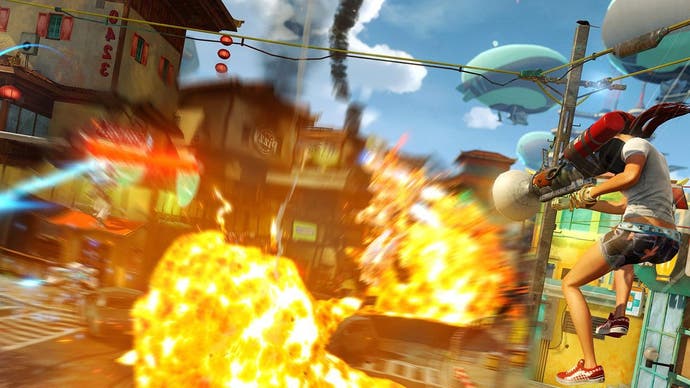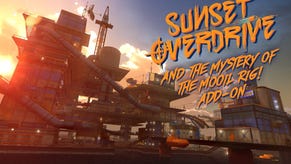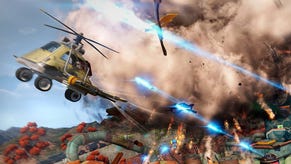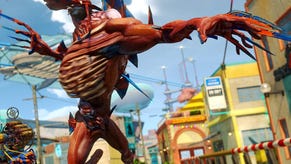Spider-Man and Sunset Overdrive share a secret ingredient
And it's not just the same developer.
Games get really interesting, I think, when designers start to think about what the player won't be able to do as much as they think about what they will be able to do. It's all a bit topsy-turvy. In my head, at least, games start with lists of possibilities and positives. What if you could eat a mushroom and grow really giant? What if you could move in every direction and shoot in every direction at the same time? But there are games out there that I really suspect were built in a very different way. And it turns out I've spent the last month playing one of them, and the last week playing another. They are both rich in joy, and they're both by the same developer. Jeepers!
Let's look at the game I've been playing this week first. In an attempt to step away from Spider-Man, I've returned to Sunset Overdrive, another recent(ish) game by the Spider-Man developer, Insomniac Games. I really liked Sunset Overdrive when it first came out, and in the time since I played it, I've started to realise I probably love it. Sunset Overdrive sits so well in the memory, where all games ultimately end up anyway. It's a wonderfully addled open-world game about a city on zombie lockdown following the botched release of an energy drink that turns out to have Hyde-like properties. It's a game that's defined by gymnastic, exuberant traversal, a try-anything sense of forward momentum that sees you grinding rails, swinging beneath telephone wires, bouncing off cars and running up the sides of skyscrapers. If you're looking for games built around things you can't do, this looks like an unpromising place to start, in other words. Insomniac's design seems to have taken the kitchen sink approach.
Or has it? Loading the game up post-Spider-Man, I was surprised by the pace. Sunset Overdrive now seemed a much slower beast than I remembered: I would try to rush around, but I'd be in something of a lethargic funk, and even riding the rails didn't have quite the zip I expected. The thundering, bubbling, slobbering hordes of mutant soda-drinkers the game sends lurching after you at every street corner seemed much better at surrounding me and doing me in than I remembered. I died a lot, and I don't really remember dying a lot in Sunset Overdrive until the third act when things get almost implausibly hectic.
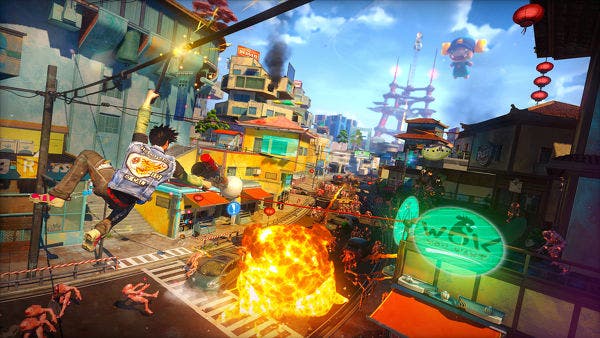
But then I started to listen to what the NPCs in Sunset Overdrive were telling me - and it turns out they were all telling me the same thing. They were saying: keep moving. Keep moving all the time. Ride the rails constantly. Bounce off cars at every opportunity you have. Never miss the chance to chain these things together. And don't stop.
And when I followed their advice, Sunset Overdrive was suddenly just as I remembered it - a game in which you could grind a rail improbably and then - even better, and even more improbable - you could flip direction and grind back the way you had come. Here was the game in all its speed and chaos. And for the first time - I am slow and you have probably long ago worked this out - I understood exactly which game I was actually playing.
A quick aside here. My wife has a particular power move when watching films, and that's to get about five minutes in and reveal, with certainty, the underlying narrative that is actually unfolding. The opening credits will have passed on Maid in Manhattan and Sarah will say, "Oh Christ, it's Cinderella." We'll be watching Groundhog Day and she'll say, "It's A Christmas Carol, isn't it?" These are quite simple examples, but honestly, she is a bit magical at this stuff. Spoiler for Lost in the next sentence so look away if you must. Early on in season two: "Lost is Charlie and the Chocolate Factory, isn't it?" (Turns out it is.)
I am terrible at this - or else I am just incredibly slow. Anyway, years late to this revelation, but Sunset Overdrive is The Floor is Lava. Even typing this I am struck by how obvious this is and how idiotic I am for having missed it. I suspect if I replayed the campaign all the way through there's even a joke about it, but regardless, it's all there anyway. It's not subtext, it's just actual text.
The Floor is Lava is that game you play where you have to move around on the furniture because putting a foot on the ground means you've lost. It encourages creative, gymnastic movement and also encourages you to stay in motion, dancing from one teetering perch to the next. Sure enough, in Sunset Overdrive, you're rubbish when you're on the ground, easily swamped by enemies and moving really sluggishly. Meanwhile, all the level architecture is pushing you upwards. Bounceables, uptick rails, guttering and canopies everywhere you look. And then a Scalextric world of interconnecting lines stretched over the top of it all. Keep moving, stay above the street, the floor is lava.
To put it another way, Sunset Overdrive is a game in which you cannot really stand still. Standing still is the thing the designers have decided that you shouldn't do - and from that simple decision, all the fun of the game spills forth.
Here's the thing, though. After playing Sunset Overdrive for a few hours, it's clear that Spider-Man is another game in which the designers have decided you should not stand still. Spider-Man is The Floor is Lava all over again. And in Spider-Man I'm pretty sure there really is an open reference to this in one of the later missions. (I missed it at the time, of course.) In Spider-Man, you're not so brilliant at street level, while you absolutely rule when swinging through the skyscraper avenues. You can't rail grind, perhaps, but you can wall-run and zap from one point to the next with a squeeze of the triggers.
In traversal, there are plenty of tricks available to see you crossing Manhattan with speed and flair, but in combat moving about is absolutely essential too. Spider-Man's combat is built around an Arkham core, but whereas Batman is about moving from one foe to another in a fairly stately manner, Spider-Man dashes in and out of danger at an incredible speed, his Capoeira-flavoured moveset encouraging you to dash around enemies, closing the distance and then opening it up again, diving between legs, and zipping up to a corner of the arena to get a few moments of safety and a health recharge.
I had known going in that Spider-Man reminded me of Sunset Overdrive in ways that went beyond both games having the charming hallmarks of the same charming developer. I figured it was because both games seemed to really enjoy traversal, that both games were a pleasure to simply rattle around inside. But it goes deeper - they both tacitly play upon this brilliant idea: they both play upon the cost of standing still.

And the cost of standing still is a great thing to build a game around, I reckon. It affects your movement options - when you're encouraged to move all the time, there should be a richness and charisma in the way that you can move. But it also affects the environment. Spider-Man, for example, is one of few open-world games that hasn't run aground in the surprisingly unpromising environment of New York, which is big on canyons and fairly low on wide open spaces. The reason it works is because when the floor is lava, you want to move around and above your enemies - those canyons are perfect for letting you zip back and forth over the churning horde, in the same way Sunset Overdrive's city is full of streets that act like rivers and deltas, while you move overhead from one bank to the next.
And it ultimately affects the tone of the game. Spider-Man and Sunset Overdrive both make you feel - what's the word? Weirdly, I think the word is mischievous. You don't tackle your enemies directly, one-on-one here. Your limitations force you to find the way to tip environments and confrontations in your favour. Both games encourage you to prank your way to victory, with gadgets and gizmos and crazy weapons, sure, but also with a refusal to stay still and play by your enemies' rules. Instead, you play by the game's rules - up high and constantly in motion.
Intriguingly, I'd argue that both games embrace this design limitation in very different ways, however. And both explore the virtues of their differing approaches. Above all else, Spider-Man is focused on Spider-Man. It has to obey the limitations that come with the character, the things he will and will not do, the things that can and cannot happen in his world. But it also gets the richness that comes from a genuine exploration of that character and his world. Spider-Man is an exercise about staying within the boundaries of what's possible and trying to make things work.
Sunset Overdrive, on the other hand, is a world in which almost anything at all is possible - and the game makes the most of that too. This can make things seem unfocused at times, but it also allows for great flights of fancy - and stuff like bounceables, objects scattered around that immediately allow you to get height and get up off the streets. Bounceables are an excellent idea for open-world traversal, but you'd never get away with them in a game like Assassin's Creed or Spider-Man. These games are hardly realistic, but they have imposed their own reality that still has very firm ideas about what's in and what's out.
Perhaps the best thing of all about this discovery of mine is that it's already sending me elsewhere. A while back, Klei Entertainment, a studio whose ingenious, delightful, challenging games are always worth checking out, made a speedy platformer called Hot Lava, which is explicitly all about playing The Floor is Lava. For whatever reason I'd given it a miss so far. But now? Now my Spider Sense is tingling.
